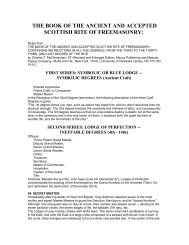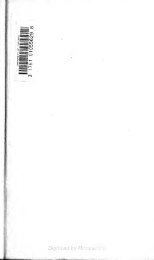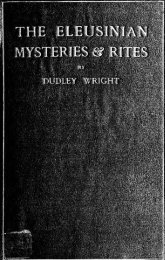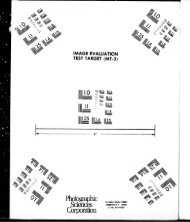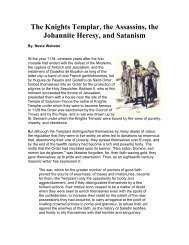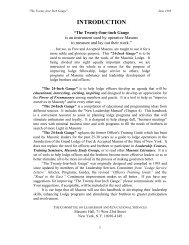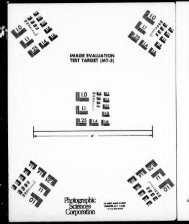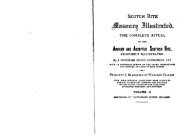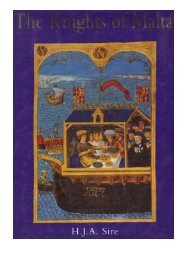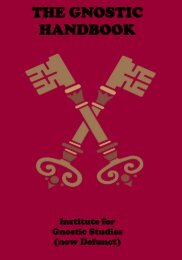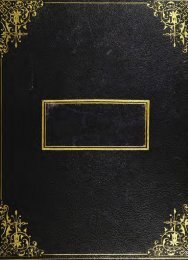The History of Initiation - The Masonic Trowel
The History of Initiation - The Masonic Trowel
The History of Initiation - The Masonic Trowel
Create successful ePaper yourself
Turn your PDF publications into a flip-book with our unique Google optimized e-Paper software.
210 HISTORY OF INITIATION<br />
<strong>The</strong>y worshipped a Triad <strong>of</strong> deity, for Acosta says, 77<br />
they<br />
had an idol whom they called Tangatanga, which signifies,<br />
One in Three, and Three in One; and paid divine<br />
honours to the Sun79 80<br />
as the fountain <strong>of</strong> Light, and the<br />
81<br />
<strong>of</strong> the Incas.<br />
parent<br />
On their great annual festival, which was held on the<br />
first day <strong>of</strong> the September moon, their secret mysteries<br />
were celebrated, which they believed would convey a<br />
77 Cerem. <strong>of</strong> Var. Nat., p. 412.<br />
78 Faber (Pag. Idol, vol. i.. p. 269) says they entertained a belief<br />
"<br />
in two other triads. <strong>The</strong> first consisted <strong>of</strong> Chuquilla Catuilla<br />
Intylappa, or the father-thunder, the son-thunder, and the brother-<br />
the father-<br />
thunder the second <strong>of</strong> ; Apomti Churunti Intiquaoqui,<br />
Sun, the son-Sun, and the brother-Sun."<br />
79 " At Cusco was that wonderful temple <strong>of</strong> the sun, the beauty and<br />
riches where<strong>of</strong> surpassed imagination. I shall transcribe the description<br />
which one <strong>of</strong> their Incas. called Garcilasso, has given us there<strong>of</strong>.<br />
'<br />
His words are as follow : <strong>The</strong> high altar <strong>of</strong> this pompous edifice<br />
stood eastward and the ;<br />
ro<strong>of</strong>, which was made <strong>of</strong> timber, was thatched<br />
over, they having no tile or brick among them. <strong>The</strong> four walls <strong>of</strong> the<br />
temple, from the top downwards, were all covered over with plates <strong>of</strong><br />
gold, and the ceiling was also <strong>of</strong> gold. On the high altar was the<br />
figure <strong>of</strong> the sun, represented on a gold plate, twice as thick as those<br />
which covered the walls. This figure, which was made <strong>of</strong> one continued<br />
piece, represented a round face, surrounded with rays and<br />
flames, in the same manner as our painters usually draw the sun. It<br />
was <strong>of</strong> so prodigious a breadth, that it almost covered one side <strong>of</strong> the<br />
wall, on which there was no other representation <strong>of</strong> any kind. This<br />
was the only one the Peruvians had, either in that or any other temple.<br />
On each side <strong>of</strong> the image <strong>of</strong> the sun, the several bodies <strong>of</strong> their<br />
deceased incas, or monarchs, were ranged in order, according to the<br />
course <strong>of</strong> their respective reigns, and 'so embalmed (the manner <strong>of</strong><br />
which is not known to us) that they seemed to be alive. <strong>The</strong>y were<br />
seated on thrones <strong>of</strong> gold, raised on plates <strong>of</strong> the same metal, with<br />
their faces looking towards the bottom <strong>of</strong> the temple. This temple<br />
had several gates, which were all covered with plates <strong>of</strong> gold, the<br />
chief <strong>of</strong> which looked towards the north, as it still does to this day.<br />
Moreover, round the walls <strong>of</strong> this temple, on the outside, was a cornice<br />
<strong>of</strong> gold, in the shape <strong>of</strong> a crown or garland, more than a yard broad.<br />
On one side <strong>of</strong> the temple was a cloister, built in a quadrangular form ;<br />
and in its highest enclosure a garland <strong>of</strong> pure gold, an ell broad, like<br />
the above-mentioned. Round this cloister were five square pavilions,<br />
or houses, covered over in the shape <strong>of</strong> a pyramid. <strong>The</strong> first was<br />
built for the habitation <strong>of</strong> the moon, the sun's wife, and stood the<br />
nearest to the great chapel <strong>of</strong> the temple. <strong>The</strong> doors and enclosures<br />
<strong>of</strong> it were covered with silver plates ; its white colour denoting that<br />
it was the apartment allotted to the moon, whose figure was represented<br />
like that <strong>of</strong> the sun but with this ; difference, that it stood<br />
upon a silver plate, and was represented with a '<br />
woman's face."<br />
(Univ. Dis., vol.<br />
i., p. 268, 269.)<br />
80<br />
liaynal. Hist. Ind., vol. iii., p. 20.<br />
81 Marm. Incas, vol ii., p 40



